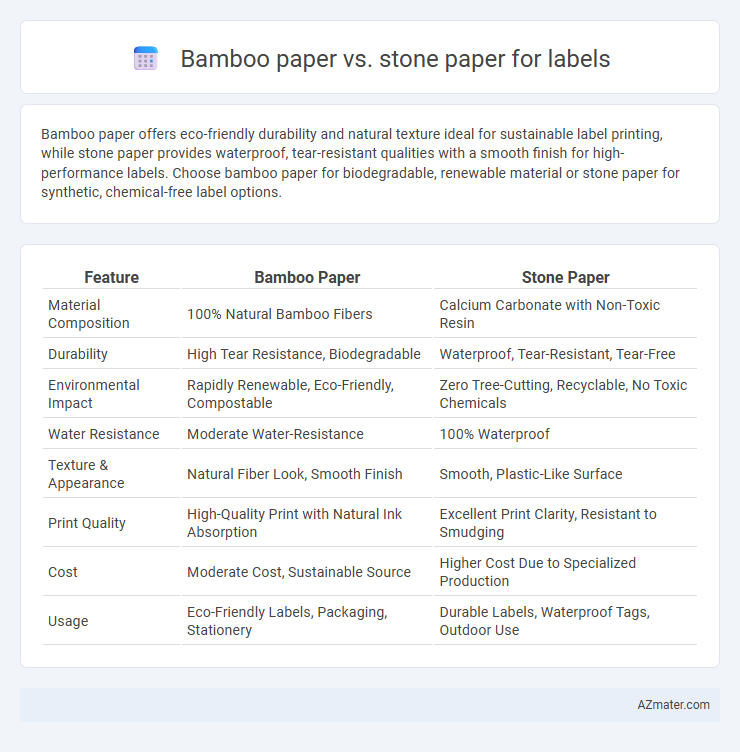Bamboo paper offers eco-friendly durability and natural texture ideal for sustainable label printing, while stone paper provides waterproof, tear-resistant qualities with a smooth finish for high-performance labels. Choose bamboo paper for biodegradable, renewable material or stone paper for synthetic, chemical-free label options.
Table of Comparison
| Feature | Bamboo Paper | Stone Paper |
|---|---|---|
| Material Composition | 100% Natural Bamboo Fibers | Calcium Carbonate with Non-Toxic Resin |
| Durability | High Tear Resistance, Biodegradable | Waterproof, Tear-Resistant, Tear-Free |
| Environmental Impact | Rapidly Renewable, Eco-Friendly, Compostable | Zero Tree-Cutting, Recyclable, No Toxic Chemicals |
| Water Resistance | Moderate Water-Resistance | 100% Waterproof |
| Texture & Appearance | Natural Fiber Look, Smooth Finish | Smooth, Plastic-Like Surface |
| Print Quality | High-Quality Print with Natural Ink Absorption | Excellent Print Clarity, Resistant to Smudging |
| Cost | Moderate Cost, Sustainable Source | Higher Cost Due to Specialized Production |
| Usage | Eco-Friendly Labels, Packaging, Stationery | Durable Labels, Waterproof Tags, Outdoor Use |
Introduction to Eco-Friendly Label Materials
Bamboo paper and stone paper are innovative eco-friendly label materials that offer sustainable alternatives to traditional paper. Bamboo paper is made from fast-growing bamboo fibers, which require less water and pesticides, making it highly renewable and biodegradable. Stone paper, produced from calcium carbonate bonded with non-toxic resins, provides a waterproof, tear-resistant, and tree-free option that reduces deforestation and carbon emissions.
What is Bamboo Paper?
Bamboo paper is an eco-friendly alternative made from bamboo pulp, known for its strength, flexibility, and smooth texture, making it ideal for labels requiring durability and a natural aesthetic. It boasts high tear resistance and is biodegradable, appealing to sustainable branding efforts. Bamboo paper's renewable source contributes to reducing deforestation and lowering carbon footprints compared to traditional wood-based or stone paper materials.
What is Stone Paper?
Stone paper is a sustainable alternative made from calcium carbonate bonded with non-toxic resin, offering a durable, water-resistant, and tear-proof material ideal for labels. Unlike bamboo paper, which is derived from bamboo fibers, stone paper provides a plastic-free, eco-friendly option with a smooth texture that enhances print quality and longevity. Its production requires no water or harmful chemicals, making it a more environmentally responsible choice for labeling needs.
Environmental Impact: Bamboo Paper vs Stone Paper
Bamboo paper for labels offers a renewable resource advantage, as bamboo grows rapidly and requires minimal water and pesticides, reducing deforestation and chemical pollution. Stone paper production uses calcium carbonate and resin, eliminating tree cutting and consuming less water, but relies on non-biodegradable plastic which can affect long-term environmental health. Overall, bamboo paper tends to have a lower carbon footprint and better biodegradability, while stone paper provides durability with a trade-off of microplastic waste concerns.
Production Process Comparison
Bamboo paper production relies on fast-growing bamboo fibers, processed through pulping and bleaching methods that consume less water and chemicals compared to traditional wood paper. Stone paper manufacturing uses non-toxic calcium carbonate bonded with high-density polyethylene, eliminating the need for water and reducing energy use by up to 50%. The production process of bamboo paper results in biodegradable labels, while stone paper offers waterproof, tear-resistant labels with minimal environmental impact from raw material extraction.
Print Quality and Performance
Bamboo paper offers excellent print quality with vibrant color reproduction and smooth texture, ideal for high-resolution label printing. Stone paper boasts superior durability and water resistance, enhancing label performance in harsh environments without smudging or fading. Both materials support eco-friendly production, but bamboo paper excels in tactile feel while stone paper delivers longer-lasting labels.
Durability and Water Resistance
Bamboo paper offers moderate durability and water resistance, making it suitable for labels exposed to occasional moisture but prone to tearing under heavy wear. Stone paper excels in durability with its tear-resistant, waterproof properties, ideal for labels requiring long-lasting performance in harsh, wet environments. Both materials are eco-friendly alternatives, but stone paper provides superior strength and moisture protection for demanding labeling applications.
Cost Differences and Market Availability
Bamboo paper generally costs less than stone paper due to lower raw material expenses and established manufacturing processes, making it more accessible for label production. Stone paper involves higher costs because of its unique mineral-based composition and specialized production, limiting its widespread market availability. The cost efficiency and easier procurement of bamboo paper contribute to its dominance in labels, while stone paper remains a niche option with growing but limited market presence.
Applications in Labeling Industry
Bamboo paper offers eco-friendly, biodegradable labeling solutions ideal for organic and sustainable product packaging, with excellent printability and durability for short-term use. Stone paper provides water-resistant, tear-proof labels suitable for harsh environments, such as industrial and outdoor labeling, ensuring long-lasting adhesion and resistance to moisture and chemicals. Both materials cater to specific niche markets in the labeling industry, with bamboo paper preferred for eco-conscious brands and stone paper favored for rugged applications demanding durability.
Choosing the Best Option for Your Labels
Bamboo paper offers eco-friendly durability and a natural texture ideal for sustainable label printing, with excellent print clarity and biodegradability. Stone paper, made from calcium carbonate, provides waterproof, tear-resistant, and smooth surfaces, making it perfect for labels exposed to moisture or rough handling. Choosing between bamboo and stone paper depends on your label's environmental impact preferences and functional requirements such as water resistance or recyclability.

Infographic: Bamboo paper vs Stone paper for Label
 azmater.com
azmater.com